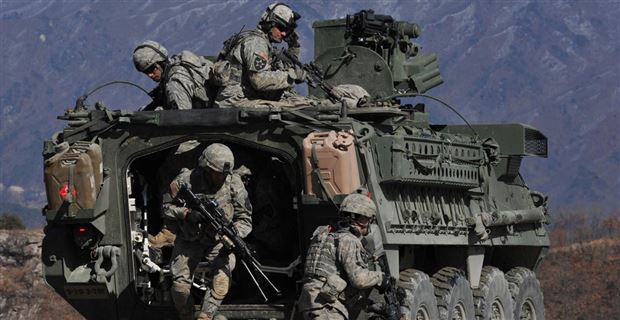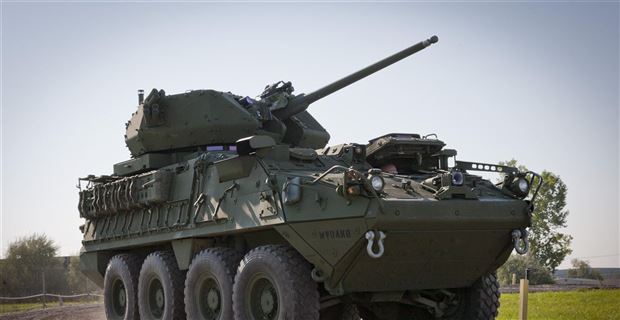Army weapons developers recently completed a "proof-of-principle" exercise with Stryker vehicles using wireless conditioned based maintenance devices, faster computer

Army weapons developers recently completed a "proof-of-principle" exercise with Stryker vehicles using wireless devices, faster computer processing speed, cloud technology and artificial intelligence to expedite vehicle health monitoring and anticipate future needs for the platform.
The initiative is tied to the Army’s recent $135 million Army Logistics Support Activity (LOGSA) renewal deal with IBM, the firm contracted to continue providing cloud services, software development and cognitive computing, constituting the technical infrastructure.
“We see huge potential benefits with cloud computing from artificial intelligence,” Col. John Kuenzli, LOGSA commander, told Warrior.
“We see huge potential benefits with cloud computing from artificial intelligence,” Col. John Kuenzli, LOGSA commander, told Warrior.
The concept behind the exercise with Stryker vehicles is to use AI to accelerate development of a fast-moving, data analytics-based wireless connectivity between sensors used for conditioned-based maintenance (CBM) and corresponding data analysis.
The Army recently experimented with these emerging technological methods using cloud computing, data analysis and AI to track CMB data on several variants of Stryker vehicles. The exercise drew from a computer database of more than 5 billion re.cords
“We did a proof of principle at using historical maintenance records looking at data to assigned sets of equipment. We matched it to the documentation with technical manuals. We can use AI to see what vehicles look like now and in the future based on miles and sensor reading. AI allows a computer to make those technical connections between engineering specifics and sensor data,” Kuenzli explained.
Rapid access to historical databases and sensor information, made available by AI-driven computer automation such as that used by IBM’s Watson, allows commanders to quickly identify and anticipate mechanical failures, equipment functionality and service life details.
As a result, wireless connectivity and more AI-driven conditioned-based maintenance expedites analysis and allows for near real-time decision-making, Army developers explained.
As a result, wireless connectivity and more AI-driven conditioned-based maintenance expedites analysis and allows for near real-time decision-making, Army developers explained.

This is also designed to give stakeholders the ability to see trends, predict outcomes, evaluate courses of action and adjust tactics when necessary, said Army spokeswoman April Cunningham.
Cunningham explained that the next technical step is to develop "store-and-forward" capability to aggregate platform data until it can be retrieved wirelessly or through a handheld device.
Cunningham explained that the next technical step is to develop "store-and-forward" capability to aggregate platform data until it can be retrieved wirelessly or through a handheld device.
The Army is working closely with both IBM and Stryker-maker General Dynamics Land Systems to implement, assess and prepare this technology.
"The Stryker vehicle is in all Army formations and General Dynamics is consistently innovating, investing and looking for solutions that will provide the Army with unmatched strength and versatility,” said Robin Porter, spokesperson, General Dynamics Land Systems. "This includes these types of capabilities."
“This capability will enable data collection and analysis in most environments and significantly reduce the bandwidth to transmit vehicle usage data to the enterprise,” Cunningham said.
CBM is engineered to transform Army maintenance and transition from a schedule-based "operate-to-failure" system to a "repair-when-needed" approach. AI-enhanced analytics engenders a greater ability to predict anticipated failures.
“CBM examines an entire system from a physics of failure perspective joined with data analytics to perform maintenance when there is evidence of need,” Kuenzli added.
Developers with IBM explain that their Watson computer can instantly access relevant historical data pools needed for data analysis.
“Watson brings an analytical edge to CBM,” said Greg Souchack, manager of service cloud solutions, IBM. “It can read and analyze pools of information to determine when or if something will malfunction or reach the end of its service life. Watson can operate in near real-time and provide continuous updates.”
CBM is engineered to transform Army maintenance and transition from a schedule-based "operate-to-failure" system to a "repair-when-needed" approach. AI-enhanced analytics engenders a greater ability to predict anticipated failures.
“CBM examines an entire system from a physics of failure perspective joined with data analytics to perform maintenance when there is evidence of need,” Kuenzli added.
Developers with IBM explain that their Watson computer can instantly access relevant historical data pools needed for data analysis.
“Watson brings an analytical edge to CBM,” said Greg Souchack, manager of service cloud solutions, IBM. “It can read and analyze pools of information to determine when or if something will malfunction or reach the end of its service life. Watson can operate in near real-time and provide continuous updates.”
One analyst explained how data aggregation and analysis, along with greater data sharing, access and interoperability, is highly dependent upon greater migration to cloud technologies.
At the same time, the clear advantages of wireless networking and faster processing speed, somewhat paradoxically, bring the disadvantage of adding security challenges. Real-time wireless transmission is, of course, inherently less secure than merely having sensors gather data to download through wired connections after the passage of time.
“We can’t just go to a Bluetooth or WiFi. We have to make sure the data is secure and protected,” Kuenzli said.
An ability to recognize mission failure more efficiently by leveraging cloud technology and AI to enable faster conditioned-based maintenance, quite understandably, brings significant tactical and financial advantages.
“The return on investment with this will be in the billions and help us prove out that we can reduce the risk of mission failure,” Kuenzli said.
“We can’t just go to a Bluetooth or WiFi. We have to make sure the data is secure and protected,” Kuenzli said.
An ability to recognize mission failure more efficiently by leveraging cloud technology and AI to enable faster conditioned-based maintenance, quite understandably, brings significant tactical and financial advantages.
“The return on investment with this will be in the billions and help us prove out that we can reduce the risk of mission failure,” Kuenzli said.
Source: scout.com